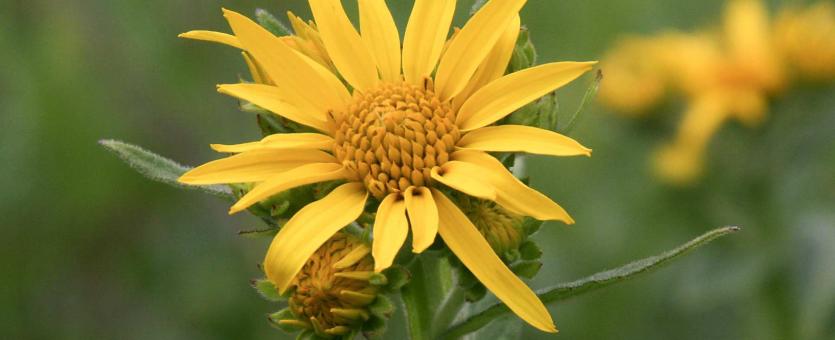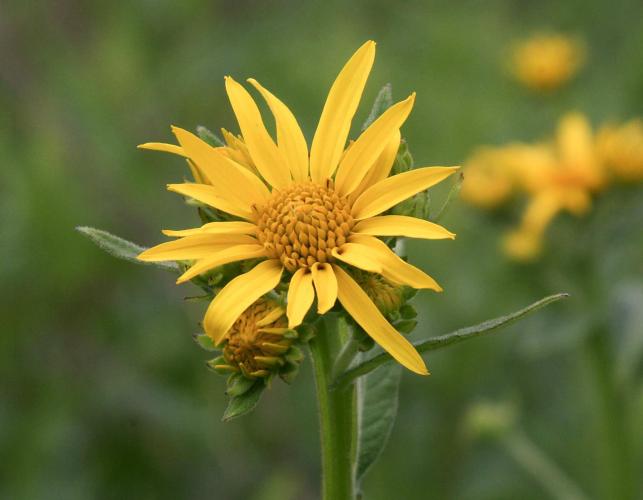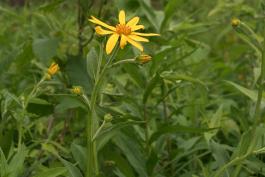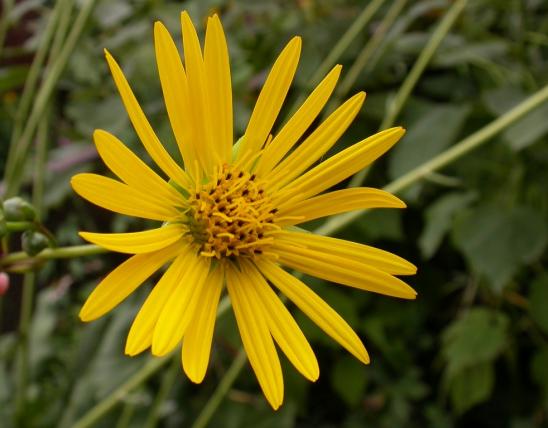
Yellow crownbeard is a medium-tall perennial with hairy, winged stems.
The flowerheads are few (1–10 per stem), yellow, with 8–15 rays spreading horizontally and varying in length. The disc florets mostly point upward, and the fruiting head appears more or less hemispherical. Blooms May–October.
The leaves are alternate, sessile, with the blade tissue extending down along the plant stem (this is one of several plants called "wingstems"), ovate-lanceolate, 2½–6 inches long, with widely spaced, small teeth; the upper surface is moderately to densely hairy (sometimes roughened to the touch); the lower surface is densely pubescent with appressed to spreading hairs (and usually felty to the touch).
Similar species: There are 4 other species of Verbesina in Missouri:
- White crownbeard (V. virginica) has clusters of smaller, white flowerheads.
- Golden crownbeard (V. encelioides) has yellow flowers, but it is uncommon and has well-defined, rather long leaf stems (petioles). The stems aren't winged, and it's an annual.
- Yellow ironweed (V. alternifolia) has yellow flowers, but it has 8–100 flowerheads per stem; the flowerheads are less showy, with the petal-like ray florets drooping downward, the tubular disc florets relatively long and pointing in all directions, and the fruiting head appearing almost spherical. Its leaves are strongly roughened with pustular-based hairs on the upper surface, similar but less rough on the lower surface.
- Southern crownbeard, also called yellow crownbeard and stickweed (V. occidentalis), is quite similar to yellow ironweed (it confuses even experienced botanists), but it has opposite leaves that are broadly ovate (not lanceolate), and its flowerheads have only 2–5 ray flowers. In Missouri, it’s known from only one location, in Miller County. May eventually be found in southeastern Missouri.
Height: 20 inches to nearly 4 feet (sometimes shorter). Yellow crownbeard is the shortest of Missouri's four Verbesina species.

Scattered south of Missouri River and northeast into Linn, Macon, and Ralls counties.
Habitat and Conservation
Occurs in upland prairies, savannas, glades, and upland forests, and along railroads and roadsides. Look for it in open and rocky areas.
Status
Native Missouri wildflower.
Human Connections
With the popularity and importance of native wildflower gardening increasing, yellow crownbeard is finding a place in landscaping. Although this species might be the prettiest Missouri crownbeard, is not showy enough for some applications, such as in borders, but in wildflower meadows, native plant gardens, or situations where it can naturalize, it offers much to pollinators and birds. Collect seed from wild plants, or purchase starts from reputable wildflower nurseries. Never dig plants from the wild.
The genus name, helianthoides, means "like a sunflower." This is a good way to remember that the flowerheads of yellow crownbeard are showier and appear more as individuals than the similar yellow ironweed, whose profuse clusters of less-showy flowerheads make it that plant look less like a sunflower.
Although this species is not a standout for it, some close relatives in genus Verbesina can form spectacular, photogenic formations called frost flowers in early fall. A sudden overnight hard freeze ruptures the stem, and sap oozes out and freezes into intricate, petal-like shapes, which melt like frost in the morning sun. Apparently, yellow crownbeard's vein, stem, and root structure, or the chemistry of its sap or an ability to go dormant before frost, prevent it from forming frost flowers.
Ecosystem Connections
Mammals and several birds, including quail and songbirds, eat the seeds.
Yellow crownbeard, like other flowers that bloom late into the growing season, provides nectar and pollen for many types of bees, butterflies, wasps, and other insects.
The silvery checkerspot butterfly and the gold moth (a noctuid) use this species and its relatives as caterpillar food plants.

































